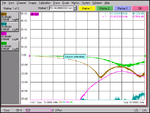esmailiyan
Newbie
Hi:
recently i have measured my mw-lna but i think that something is wrong with the output S parameters. i put the output results. do you think S parameters are normal? does amplification happen? is the LNA stable? or its a normal failed LNA? can you find the problem by just looking at the S parameters?
many thanks

recently i have measured my mw-lna but i think that something is wrong with the output S parameters. i put the output results. do you think S parameters are normal? does amplification happen? is the LNA stable? or its a normal failed LNA? can you find the problem by just looking at the S parameters?
many thanks
